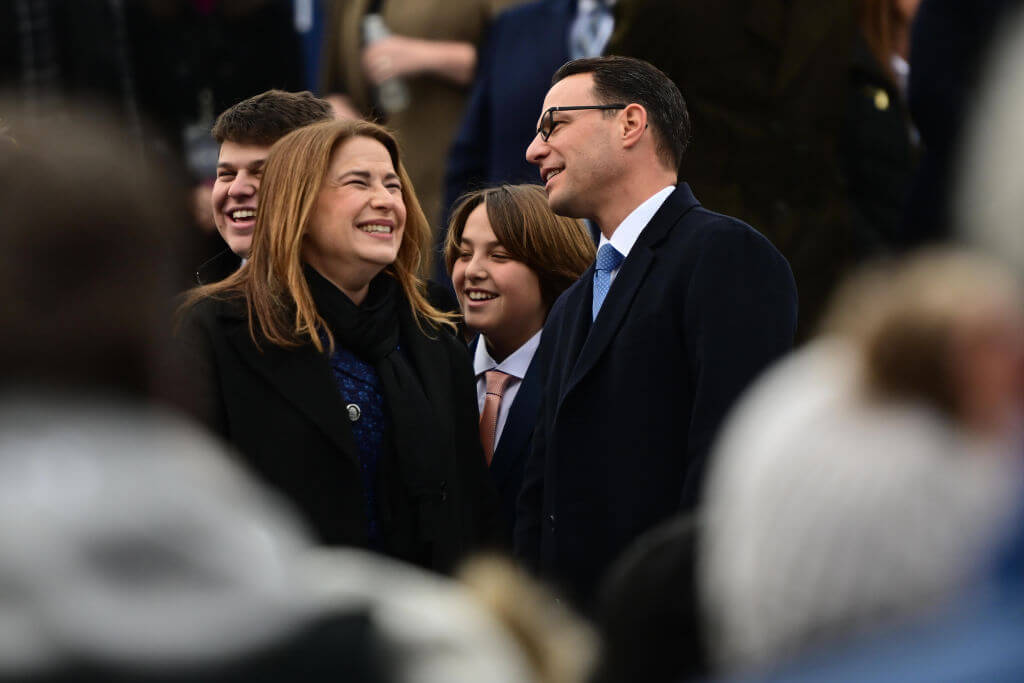Ugandan Jews’ Hopes Rise With New Chief Rabbi

TOP OF THE HILL: Gershom Sizomu (center) steps into the rabbinate, accompanied by his mother and brother.
Nabugoye Hill, Uganda – Atop Nabugoye Hill, I joined 1,500 sojourners in the flower-filled green of Eastern Uganda, among banana plantations, maize fields, mango trees and drooping jackfruit.

TOP OF THE HILL: Gershom Sizomu (center) steps into the rabbinate, accompanied by his mother and brother.
The crowd was there, overlooking the Mount Elgon foothills, to witness the installation ceremony of Rabbi Gershom Sizomu, who, serenaded by drum and dance ensembles, took his place as the first sub-Saharan African rabbi of the Abayudaya (Lugandan for “Children of Judah”) and chief rabbi of Uganda.
Joined by his wife Tzipporah, and their three children, Igaal, Daphna and Navah, Sizomu spent the past five years in the United States as a student at American Jewish University’s Ziegler School of Rabbinic Studies in Los Angeles, where he trained to become a Conservative rabbi. Following his ordination this past May in the United States, Sizomu returned home to Nabugoye Hill to serve the 89-year-old Abayudaya community, founded in 1919 by Semei Kakungulu, a local military leader and renowned elephant hunter.
Many Abayudaya members said they are confident that having an “official” rabbi will help them gain greater acceptance by the global Jewish community. Among them is Moses Sebagabo, born and raised on Nabugoye Hill. Sebagabo described Sizomu’s installation as a “unifying moment” offering “new potential to grow and learn.” Sebagabo is married with two children and holds a law degree, but he dreams of someday becoming a rabbi.
“I want to judge people equally,” Sebagabo explained, “and this I can do only with Torah. I want to use Torah to better the world.”
With five synagogues in Uganda — three of which are little more than mud huts — and a yeshiva that is currently being built, Sebagabo hopes to join Sizomu as part of a rabbinic team. Should funding become available, Sebagabo hopes to follow Sizomu’s lead to become the second member of the Abuydaya to receive formal rabbinic training outside Uganda.
Semei Kakungulu, founder of the Abayudaya community, was originally a Christian, but he became unconvinced by the teachings of the New Testament. He resisted the influence of surrounding Christian missionaries and began leading a Jewish life. Kakungulu and his 3,000 followers lived in the region as sustenance farmers, adopting the Jewish dietary practices, observance of the Sabbath and circumcision, all of which they learned from a Jewish visitor from Jerusalem who stayed with the community for six months in the 1920s. Nearly half a century later, Uganda’s oppressive military regimes of the 1960s and ’70s outlawed Judaism, shrinking the Abayudaya to a mere 300. Yet, the hill and its people survived.
Today, with a population estimated at 900 to 1,050, Nabugoye Hill has erected two Jewish schools open to Abayudaya children as well as to neighboring Muslims and Christians. At its base sits the refuah sh’leima health clinic bordered by the Moses Synagogue, where the glow of Sabbath candles illuminates lizards on the stucco sanctuary walls, and where prayer is a fusion of Hebrew and Luganda, ringing with harmonies, drumming, and ululating shrills.
The past few decades have yielded a growing relationship between the Abayudaya and the American Jewish community. Organizations such as Kulanu, based in New York City, have helped the Abayudaya grow —from commissioning the community’s first running water system, to constructing new classrooms, to developing a public health education program. The American-Abayudaya relationship further evolved in 2002, when a group of Conservative rabbis and rabbinical students visited Nabugoye Hill to establish rabbinical courts and officially convert the Abayudaya to Judaism in the absence of concrete ancestral ties. More than half the community underwent the practice, complete with a ritual bath in the synagogue’s mikveh, a pool in the middle of a cornfield.
Now, six years later, Sizomu’s homecoming marks a new wave of change for the community. After a succession of self-taught spiritual leaders — among them, Sizomu’s father, grandfather and Sizomu himself — Sizomu is the first to receive formal rabbinic training, bringing the Abayudaya to deeper contact with Western Judaism.
“I return to Nabugoye Hill with the powerful responsibility to share my knowledge and help our Jewish community grow more learned,” Sizomu said during the ceremony. “I am committed to advancing educational opportunities for my fellow brothers and sisters, and I thank you for accepting my leadership.”
The installation began with lively entertainment from indigenous song-and-dance troupes comprising Abayudaya children; Muslim and Christian singers, and orphaned, AIDS-afflicted adolescents. The Ugandan national anthem and “HaTikvah” followed the performances. Rabbi Bradley Shavit Artson, American Jewish University’s dean of the Ziegler School of Rabbinic Studies, offered a welcome speech followed by remarks from Ugandan government officials. Two kilometers from a pit once used by the Abayudaya to ferment bananas for Sabbath wine, Rabbi Richard Camras, Sizomu’s personal mentor and rabbi of Shomrei Torah Synagogue in West Hills, Calif., led a Kiddush ceremony and the recitation of the Kohanic priestly blessings.
Where I sat, to my right, was a row of local imams from neighboring Muslim communities; the imams wore long white robes. To my left were the dignified matriarchal figures of the Abayudaya, wearing cranberry- and lime-colored dresses with puffed sleeves and patterned headscarves. An arm’s length away, American Jewish volunteers met the gazes of Ugandan dignitaries as Israeli backpackers plunked their gear in the grass.
Perhaps the most notable attendees were the world’s newest Jews, from Nigeria, Ghana, Kenya and Tanzania. Twenty-four hours earlier, these Africans, along with 250 others, stood in front of a beit din (rabbinical court) — upon which Sizomu sat — to undergo Jewish conversions officiated by Conservative rabbis from the United States. These Africans have studied and lived as Jews for quite some time. Excited by Sizomu’s return to Africa, and with the expectation that his knowledge will both strengthen and expand pan-African Jewry, many “new” African Jews traveled great distances to attend Sizomu’s installation.
Conservative Judaism’s encounter with the Abayudaya unearths a slew of questions concerning the mixing of culture with ritual practice and theological interpretation. In a community in which women have, traditionally, neither chanted from the Torah nor led services, what will it mean to have a rabbi ordained by a movement in which women’s religious leadership is welcome? In a community in which instrumental music is an essential part of prayer, what will it mean for a community to embrace the rabbinic leadership of Sizomu who, in recent years, has come to know its absence?
As Judaism takes a stronger hold in Africa, there is likely more history to be made on Nabugoye Hill and on other hills in the sub-Saharan communities where newly converted African Jews returned after Sizomu’s installation.
“How does this feel for you?” I asked Natan, a Nigerian Jew who taught me new melodies and a special additional prayer to say during Havdalah, the ceremony that concludes the Sabbath.
“It feels like the coming together of worlds,” he said, “full of powerful joy.”
Jordan Namerow was in Uganda as a volunteer with the American Jewish World Service.
The Forward is free to read, but it isn’t free to produce

I hope you appreciated this article. Before you go, I’d like to ask you to please support the Forward.
Now more than ever, American Jews need independent news they can trust, with reporting driven by truth, not ideology. We serve you, not any ideological agenda.
At a time when other newsrooms are closing or cutting back, the Forward has removed its paywall and invested additional resources to report on the ground from Israel and around the U.S. on the impact of the war, rising antisemitism and polarized discourse.
This is a great time to support independent Jewish journalism you rely on. Make a Passover gift today!
— Rachel Fishman Feddersen, Publisher and CEO
Most Popular
- 1

Opinion My Jewish moms group ousted me because I work for J Street. Is this what communal life has come to?
- 2

Fast Forward Suspected arsonist intended to beat Gov. Josh Shapiro with a sledgehammer, investigators say
- 3

Fast Forward How Coke’s Passover recipe sparked an antisemitic conspiracy theory
- 4

Politics Meet America’s potential first Jewish second family: Josh Shapiro, Lori, and their 4 kids
In Case You Missed It
-

Opinion This Nazi-era story shows why Trump won’t fix a terrifying deportation mistake
-

Opinion I operate a small Judaica business. Trump’s tariffs are going to squelch Jewish innovation.
-

Fast Forward Language apps are putting Hebrew school in teens’ back pockets. But do they work?
-

Books How a Jewish boy from Canterbury became a Zulu chieftain
-
Shop the Forward Store
100% of profits support our journalism
Republish This Story
Please read before republishing
We’re happy to make this story available to republish for free, unless it originated with JTA, Haaretz or another publication (as indicated on the article) and as long as you follow our guidelines.
You must comply with the following:
- Credit the Forward
- Retain our pixel
- Preserve our canonical link in Google search
- Add a noindex tag in Google search
See our full guidelines for more information, and this guide for detail about canonical URLs.
To republish, copy the HTML by clicking on the yellow button to the right; it includes our tracking pixel, all paragraph styles and hyperlinks, the author byline and credit to the Forward. It does not include images; to avoid copyright violations, you must add them manually, following our guidelines. Please email us at [email protected], subject line “republish,” with any questions or to let us know what stories you’re picking up.
















